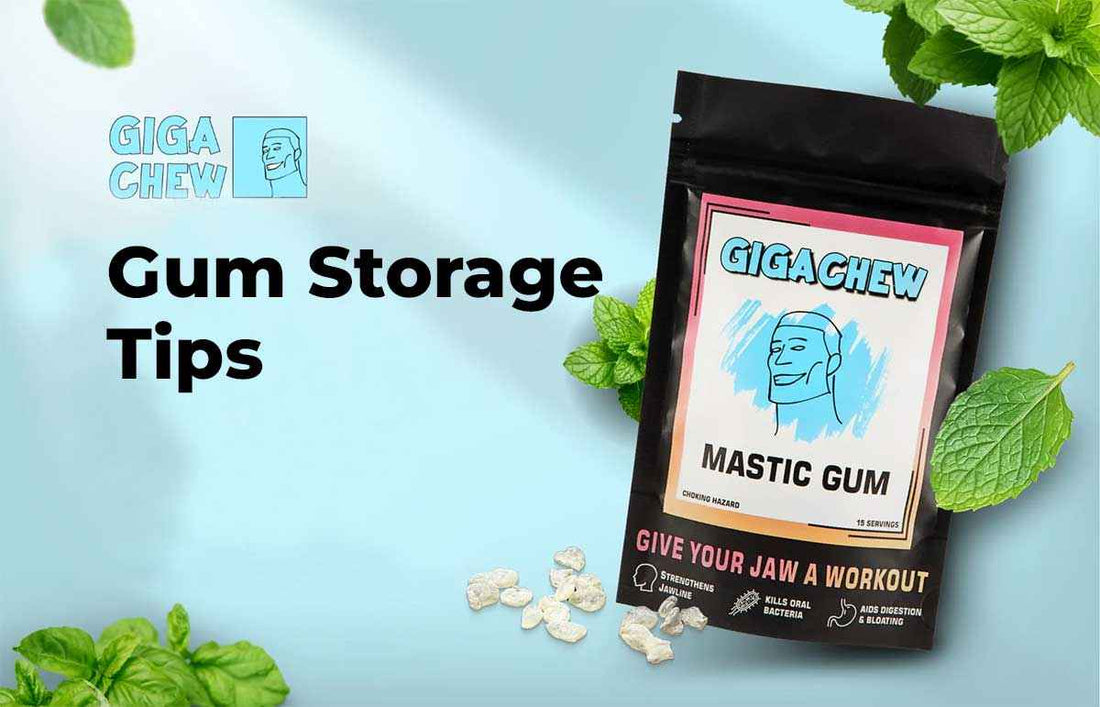Resistance gum is designed to challenge your jaw and deliver a lasting chew. But without proper storage, even the highest quality gum can lose its strength and texture. Giga Chew ensures that performance isn’t compromised by poor preservation. Whether you’re using gum for fitness or focus, knowing how to store it right helps maintain its durability, flavour, and bounce, keeping every chew as effective as the first.
Table of Contents
- Key Takeaways
- Understanding Resistance Gum
- Why Resistance Gum Chew Needs Special Storage
- Key Gum Chew Storage Tips
- How Long Does Resistance Gum Last?
- Additional Hygiene and Preservation Tips
- Conclusion
- FAQs:
Key Takeaways
- Store in a cool, dry place to maintain texture and flavour.
- Seal your gum in airtight containers to shield it from moisture and air exposure.
- Refrigerate for long-term storage, ensuring the gum is sealed properly.
- Avoid freezing unless necessary, and thaw before use.
Understanding Resistance Gum
Resistance gum is designed to offer a firmer chew, providing benefits such as jaw line improvement, jaw muscle strengthening and stress relief. To retain these benefits, it’s crucial to store the gum correctly, preventing it from becoming hard, losing flavour, or degrading in quality.
Why Resistance Gum Chew Needs Special Storage
Giga chew mastic resistance gum is crafted to provide a firmer, more challenging chew. This helps strengthen jaw muscles and promote better oral health and facial tone. However, these benefits depend on the gum retaining its original structure and texture.
As noted by Giga Chew:
“Resistance gum is designed to challenge your jaw and deliver a lasting chew. But without proper storage, even the highest quality gum can lose its strength and texture.”
Over time, exposure to moisture, air, temperature shifts, and contamination can break down the gum’s elasticity, diminish flavour, or make it unhygienic for continued use. Understanding and implementing the right storage methods will significantly prolong the gum’s usability and safety.
Unlike standard gum, which is disposable and relatively low in cost, resistance gum chew is typically made of food-grade silicone, dense rubber-like compounds, or specially formulated biodegradable materials. These materials are:
- Reusable: Some resistance gums are built to last through 20–100+ sessions.
- High in Density: Their tough consistency makes them more prone to absorbing bacteria, moisture, and odours.
- Sensitive to Environment: Exposure to sunlight, humidity, or improper cleaning can break down their material or make them unsanitary.
This makes proper storage not just convenient, but necessary.
Key Gum Chew Storage Tips
1. Store in a Cool, Dry Place
Heat and humidity are two of the biggest threats to resistance gum. A warm environment can cause the gum to soften, warp, or lose its texture, while excess moisture can promote mould growth or make the gum sticky.
Ideal storage locations:
- Inside a drawer
- In a gym bag (within a pouch)
- A temperature-controlled cabinet away from sunlight
Avoid leaving your gum in cars, near windows, or next to kitchen appliances that emit heat.
2. Use Airtight Containers
Air exposure can dry out resistance gum or cause it to harden unnaturally. Use a small, airtight container, like a dental retainer box or silicone food-safe container, to keep out moisture and oxygen.
This not only preserves the gum’s bounce and flavour but also keeps it free from dust and bacteria. Airtight storage is especially crucial for resistance gum that is reused across multiple sessions.
3. Refrigerate for Long-Term Storage
If you plan on storing unused resistance gum for an extended period (weeks to months), refrigeration is a smart move. Refrigerators provide a stable, cool environment that slows down degradation and helps retain the gum’s original flavour.
However, always ensure the gum is sealed properly in an airtight container. Refrigerators can expose items to various food odours, which gum can easily absorb. Flavour transfer can make your chewing experience unpleasant.
- Important Note: Never refrigerate chewed gum. Once used, it should either be discarded or stored temporarily in a clean, hygienic container for same-day reuse only (not recommended for multiple days).
4. Avoid Freezing Unless Necessary
While freezing-resistant gum is safe, it is generally not recommended unless you’re storing it for a long time without plans to use it soon. Freezing can slightly alter the gum’s texture and make it brittle.
If you do freeze your gum, let it thaw at room temperature before use. Avoid microwaving or warming it up artificially, as uneven heat can damage the material.
5. Keep Chewed and Unchewed Gum Separate
Used gum should never be stored together with unused pieces. Aside from hygiene concerns, the moisture and bacteria from chewed gum can degrade new gum stored alongside it.
If you’re planning to reuse a piece of chewed resistance gum during the same day, store it in a clean, dedicated case, separate from other gum pieces. However, Giga Chew advises against reusing chewed gum whenever possible:
“It’s not recommended to store chewed gum for later use due to hygiene concerns and potential degradation in texture and flavour.”
6. Store Different Flavours Separately
Storing different flavours in the same container can lead to unwanted flavour mixing. If you’ve invested in multiple flavours or strengths of resistance gum, keep them in labelled, individual containers to preserve each product’s unique characteristics.
7 . Clean Thoroughly After Each Use
Before even thinking about storage, cleaning is the first step. After each chewing session:
- Rinse the gum under warm water.
- Use mild soap or a food-safe disinfectant.
- Scrub gently with a small cleaning brush if needed.
- Let it air dry completely before storage.
Never store a damp or unclean gum chew. Bacteria thrive in moist, enclosed environments and could cause dental infections or unpleasant odours.
8. Store It Away from Direct Heat and Sunlight
High temperatures and UV radiation can degrade the structure of resistance gum, especially if it contains biodegradable or natural materials. Don’t leave your gum in a hot car, near a sunny window, or next to heat sources like radiators or kitchen appliances.
Instead, store it in a drawer, gym bag compartment, or any cool, shaded area. Room temperature is ideal, avoid extremes.
9. Avoid Contact with Dirty Surfaces
Never place your resistance gum directly on countertops, gym floors, or tabletops between sessions. These surfaces may carry bacteria, food particles, or cleaning chemicals that can contaminate the gum or degrade its surface.
If you need to set it down temporarily, place it on a clean paper towel or inside its storage case.
10. Rotate or Replace Regularly
Just like any fitness or hygiene product, resistance gum has a finite lifespan. Depending on the brand and material, a single gum chew may be good for 1–3 months of regular use. Signs it’s time to replace it include:
- Cracks or surface deterioration
- Sticky or soft spots
- Foul odours, even after cleaning
- Loss of resistance or elasticity
Keeping more than one gum chew and rotating them can prolong their overall lifespan while allowing adequate drying time between uses.
11. Label Your Gum Chews
If more than one person in your household uses resistance gum, label individual storage containers clearly. Sharing gum chews is not recommended due to hygiene risks.
You might also label them by resistance level (light, medium, heavy), especially if you’re progressing through a structured training regimen.
12. Travel Smart
When taking your gum on the go, use a compact case that’s easy to clean. Silicone travel containers or dental retainer cases work well. Avoid putting the gum directly in your gym bag or pocket, where it may attract lint, dust, or bacteria.
Also, bring a small bottle of water or antiseptic wipes to clean the gum in case you’re between proper washing opportunities.
How Long Does Resistance Gum Last?
When stored properly, resistance gum can last up to 6 months in its original condition. Factors that affect longevity include:
- Storage temperature
- Exposure to air and light
- Whether the gum has been opened or chewed
If you notice a change in texture, loss of flavour, or visible signs of breakdown (cracking, stiffness, or stickiness), it’s time to replace the gum, even if it’s within the suggested use window.
Additional Hygiene and Preservation Tips
- Hygiene First: Always wash your hands before handling gum.
- Don’t Use If You’re Sick: Avoid chewing resistant gum when you have a cold or mouth infection to prevent contamination.
- Store Separately from Other Fitness Gear: Don’t keep gum chews in the same pouch as used gloves, bands, or gym shoes.
- Consider UV Sterilisation: Some users invest in small UV light boxes designed for dental products. These can provide extra sanitation for reusable gum chews, especially if used frequently.
- Use Clean Storage Tools: Clean your container weekly, especially if you’re storing reusable gum.
- Label Containers: Especially helpful when using multiple flavours or resistance levels.
Conclusion
Proper storage of resistance gum is essential to maintain its quality and effectiveness. By following these guidelines and learning more from our about us insights, you can ensure your gum remains fresh, effective, and ready whenever you need it. Contact Giga Chew for more information on our products and storage solutions.
FAQs:
Can I store chewed gum for later use?
It’s not recommended to store chewed gum for later use due to hygiene concerns and potential degradation in texture and flavour.
How long does resistance gum last when stored properly?
When stored in optimal conditions, resistance gum can maintain its quality for up to 6 months.
Does refrigeration affect the gum’s flavour?
Refrigeration can help preserve flavour, but ensure the gum is sealed to prevent it from absorbing other odours.
Is it safe to freeze-resistant gum?
Freezing is safe but may alter the gum’s texture. If frozen, allow it to thaw at room temperature before chewing.
Can I store different gum flavours together?
Storing different flavours together can lead to flavour mixing. It’s best to store each flavour separately in airtight containers.







